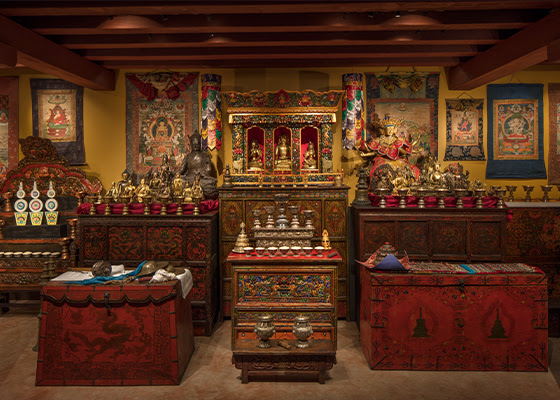
The Rubin Museum of Art and the Brooklyn Museum today announce a long-term partnership to display the Rubin’s beloved Tibetan Buddhist Shrine Room in the Brooklyn Museum’s acclaimed Arts of Asia galleries, making the installation accessible to a wide public.
Since it first opened in 2015, the Tibetan Buddhist Shrine Room has been one of the most popular exhibitions at the Rubin Museum’s 17th Street building in New York City, experienced by more than 1 million visitors. More than 100 works of art and ritual objects from the Rubin’s collection are presented as they would be in an elaborate private household shrine, where devotees would make offerings, pray, contemplate, and perform rituals. The design of the Shrine Room showcases these objects in an immersive environment that incorporates elements of traditional Tibetan architecture and the color schemes of Tibetan homes.
The Tibetan Buddhist Shrine Room will open in a custom space in the Brooklyn Museum’s Arts of Asia galleries in June 2025 as the start of a six-year collaboration. The Shrine Room is currently on view at the Rubin Museum’s 17th Street building in New York, which will close on October 6, 2024, as the museum pursues a new global museum model built on an innovative program of partnerships, grants, loans, traveling exhibitions, scholarship, and digital offerings.
A central component of the Rubin’s transformation into a decentralized museum is the formation of strategic partnerships to share its collection and curatorial expertise globally, exponentially increasing the number of visitors who can access and experience Himalayan art. This commitment includes ensuring that New York City communities and visitors continue to have access to the collection, with the Shrine Room at the Brooklyn Museum as the cornerstone of that access and an early example of the broader program.
The Rubin Museum Tibetan Buddhist Shrine Room evokes the aesthetics and atmosphere of a traditional Tibetan sacred space and offers visitors the opportunity to experience Tibetan religious art in its cultural context. It will enhance the Brooklyn Museum’s important collections of Asian art, which were fully reimagined in a major gallery renovation that was unveiled gradually from 2017 to 2023. The addition of the Shrine Room will offer a very different approach to display of historic works of art and will encourage visitors to imagine the original religious and architectural contexts for other objects on view.
At the Rubin, the installation highlighted one of the four major Tibetan religious traditions—Nyingma, Kagyü, Sakya, and Gelug—every two years. As an important part of this active and ongoing partnership, Rubin curators will continue to vary the objects in the installation at the new presentation at the Brooklyn Museum to feature specific traditions and provide cultural context and scholarship regarding the works on view.
The Shrine Room features paintings known as thangkas, sculptures, ritual items, and musical instruments arranged on traditional Tibetan furniture according to the hierarchy they assume in Tibetan Buddhist practices. The objects, such as vajras and bells, offering bowls, pitchers, and ritual mandalas are used in daily rituals and offerings along with handheld drums, conch trumpets, horns, and reeds. Ornamental textile decorations of brocade silk, made by traditional masters of appliqué craft, hung from the ceiling and on pillars, are also an integral part of a traditional shine room’s adornment. The Rubin’s Shrine Room is complete with simulated flickering butter lamps, recordings of Tibetan monks and nuns chanting prayers, and the subtle smell of incense, which is used during religious practices.

